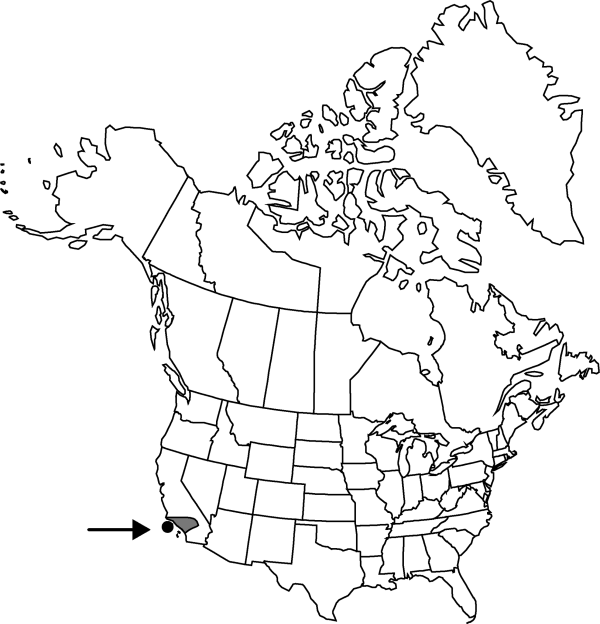Difference between revisions of "Opuntia ×occidentalis"
Proc. Amer. Acad. Arts 3: 291. 1856.
FNA>Volume Importer |
imported>Volume Importer |
||
| (7 intermediate revisions by 2 users not shown) | |||
| Line 11: | Line 11: | ||
|name=Opuntia engelmannii var. occidentalis | |name=Opuntia engelmannii var. occidentalis | ||
|authority=(Engelmann) Engelmann | |authority=(Engelmann) Engelmann | ||
| + | |rank=variety | ||
}} | }} | ||
|hierarchy=Cactaceae;Cactaceae subfam. Opuntioideae;Opuntia;Opuntia ×occidentalis | |hierarchy=Cactaceae;Cactaceae subfam. Opuntioideae;Opuntia;Opuntia ×occidentalis | ||
| Line 19: | Line 20: | ||
}}<!-- | }}<!-- | ||
| − | --><span class="statement" id="st- | + | --><span class="statement" id="st-undefined" data-properties=""><b>Shrubs,</b> sprawling to erect, to 1.5 m. <b>Stem</b> segments not disarticulating, green, flattened, obovate, 19–35 × 14–18 cm, ± tuberculate, glabrous; areoles 5–7(–8) per diagonal row across midstem segment, oblong, 5–8 × 4–6 mm; wool dark brown. <b>Spines</b> 3–6 per areole, in most areoles (rarely few spined), spreading, straight, angularly flattened, subulate; abaxial 2–4 spines reflexed, shorter, to 20 mm; adaxial 1–2 spines yellow or white chalky with brown basal portions, 25–50 mm. <b>Glochids</b> in moderately dense crescent at adaxial edge of areole and subapical tuft, reddish brown, to 6 mm. <b>Flowers</b>: inner tepals yellow to deep pink, sometimes darker blush near base, to 50 mm; filaments usually yellow or white; anthers yellow; style pink or white; stigma lobes green. <b>Fruits</b> red-purple throughout, obovoid, 45–50 × 30–40 mm, juicy, glabrous, spineless; areoles 24–30. <b>Seeds</b> yellow-tan, 4–5.5 mm; girdle protruding to 1 mm. <b>2n</b> = 66.</span><!-- |
-->{{Treatment/Body | -->{{Treatment/Body | ||
| + | |phenology=Flowering spring (Apr–May). | ||
|habitat=Coastal sage scrub, chaparral | |habitat=Coastal sage scrub, chaparral | ||
|elevation=10-500 m | |elevation=10-500 m | ||
|distribution=Calif. (including Channel Islands);Mexico (Baja California). | |distribution=Calif. (including Channel Islands);Mexico (Baja California). | ||
| − | |discussion=<p>Opuntia ×occidentalis is a hybrid complex involving three, perhaps more, species [at least O. littoralis × (O. engelmannii × O. phaeacantha)]. The hybrids are morphologically variable; the putative parents are all hexaploid. Another similar putative hybrid, O. demissa, probably involves O. oricola (B. D. Parfitt and M. A. Baker 1993).</p> | + | |discussion=<p><i>Opuntia ×occidentalis</i> is a hybrid complex involving three, perhaps more, species [at least <i>O. littoralis</i> × (<i>O. engelmannii</i> × <i>O. phaeacantha</i>)]. The hybrids are morphologically variable; the putative parents are all hexaploid. Another similar putative hybrid, O. demissa, probably involves <i>O. oricola</i> (B. D. Parfitt and M. A. Baker 1993).</p> |
|tables= | |tables= | ||
|references= | |references= | ||
| Line 34: | Line 36: | ||
-->{{#Taxon: | -->{{#Taxon: | ||
name=Opuntia ×occidentalis | name=Opuntia ×occidentalis | ||
| − | |||
|authority=Engelmann | |authority=Engelmann | ||
|rank=species | |rank=species | ||
| Line 41: | Line 42: | ||
|basionyms= | |basionyms= | ||
|family=Cactaceae | |family=Cactaceae | ||
| + | |phenology=Flowering spring (Apr–May). | ||
|habitat=Coastal sage scrub, chaparral | |habitat=Coastal sage scrub, chaparral | ||
|elevation=10-500 m | |elevation=10-500 m | ||
| Line 48: | Line 50: | ||
|publication year=1856 | |publication year=1856 | ||
|special status= | |special status= | ||
| − | |source xml=https:// | + | |source xml=https://bitbucket.org/aafc-mbb/fna-data-curation/src/2e0870ddd59836b60bcf96646a41e87ea5a5943a/coarse_grained_fna_xml/V4/V4_268.xml |
|subfamily=Cactaceae subfam. Opuntioideae | |subfamily=Cactaceae subfam. Opuntioideae | ||
|genus=Opuntia | |genus=Opuntia | ||
|species=Opuntia ×occidentalis | |species=Opuntia ×occidentalis | ||
| − | |||
| − | |||
| − | |||
| − | |||
| − | |||
| − | |||
| − | |||
| − | |||
| − | |||
| − | |||
| − | |||
| − | |||
| − | |||
| − | |||
| − | |||
| − | |||
| − | |||
| − | |||
| − | |||
| − | |||
| − | |||
| − | |||
| − | |||
| − | |||
| − | |||
| − | |||
| − | |||
| − | |||
| − | |||
| − | |||
| − | |||
| − | |||
| − | |||
| − | |||
| − | |||
| − | |||
| − | |||
| − | |||
| − | |||
| − | |||
| − | |||
| − | |||
| − | |||
| − | |||
}}<!-- | }}<!-- | ||
-->[[Category:Treatment]][[Category:Opuntia]] | -->[[Category:Treatment]][[Category:Opuntia]] | ||
Latest revision as of 22:57, 5 November 2020
Shrubs, sprawling to erect, to 1.5 m. Stem segments not disarticulating, green, flattened, obovate, 19–35 × 14–18 cm, ± tuberculate, glabrous; areoles 5–7(–8) per diagonal row across midstem segment, oblong, 5–8 × 4–6 mm; wool dark brown. Spines 3–6 per areole, in most areoles (rarely few spined), spreading, straight, angularly flattened, subulate; abaxial 2–4 spines reflexed, shorter, to 20 mm; adaxial 1–2 spines yellow or white chalky with brown basal portions, 25–50 mm. Glochids in moderately dense crescent at adaxial edge of areole and subapical tuft, reddish brown, to 6 mm. Flowers: inner tepals yellow to deep pink, sometimes darker blush near base, to 50 mm; filaments usually yellow or white; anthers yellow; style pink or white; stigma lobes green. Fruits red-purple throughout, obovoid, 45–50 × 30–40 mm, juicy, glabrous, spineless; areoles 24–30. Seeds yellow-tan, 4–5.5 mm; girdle protruding to 1 mm. 2n = 66.
Phenology: Flowering spring (Apr–May).
Habitat: Coastal sage scrub, chaparral
Elevation: 10-500 m
Distribution

Calif. (including Channel Islands), Mexico (Baja California).
Discussion
Opuntia ×occidentalis is a hybrid complex involving three, perhaps more, species [at least O. littoralis × (O. engelmannii × O. phaeacantha)]. The hybrids are morphologically variable; the putative parents are all hexaploid. Another similar putative hybrid, O. demissa, probably involves O. oricola (B. D. Parfitt and M. A. Baker 1993).
Selected References
None.